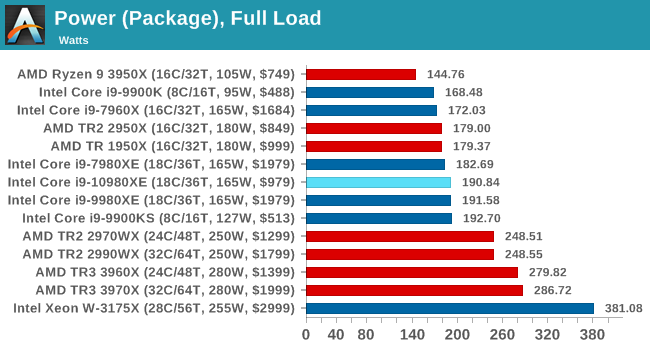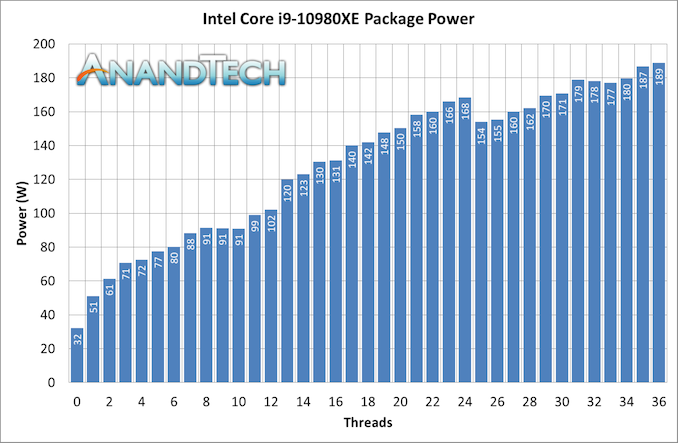It’s a Cascade of 14nm CPUs: AnandTech’s Intel Core i9-10980XE Review
by Dr. Ian Cutress on November 25, 2019 9:00 AM ESTPower Consumption
We’ve covered in detail across multiple articles the story of Intel’s turbo: about how the TDP on the box doesn’t mean a whole lot, the motherboard you’re using can ultimately determine how long your CPU does turbo for, and how the power limits of the processor are ultimately decided by the motherboard manufacturer’s settings in the BIOS unless you change them. Intel only gives recommendations on peak turbo power and the length of the turbo: the only thing Intel defines is the peak frequency based on load when turbo is allowed.
Talking Intel’s TDP and Turbo
Interviewing an Intel Fellow about TDP and Turbo
Comparing Turbo: AMD and Intel
This means that an extremely conservative system might not allow the power to go above TDP, but the system capable of all the power might allow the processor to turbo ad infinitum. The reality is usually somewhere in the middle, but for a high-end desktop platform, where most of the motherboards are engineered to withstand almost anything that comes at it, we’re going to often see the situation of an elongated or persistent turbo.
It’s worth noting that for consumer workloads, most of the work can happen within a reasonable turbo – and thus sustained performance metrics aren’t that important. But today we are testing high-end desktop hardware, and because Intel doesn’t explicitly define peak turbo power or turbo length (it only provides recommendations that motherboard manufacturers can and do ignore), I obviously asked Intel what it believes that reviewers should do when trying to compare performance. The answer wasn’t very helpful: test with a range of motherboards’.
In our previous review of the Core i9-9900KS, I did two sets of tests: benchmarks at the motherboard default, and tests at the Intel recommended turbo settings. The motherboard defaults, for that motherboard in question, were essentially full turbo all the time. Intel’s recommended settings gave some decreases in the long benchmarks, around 7%, but the rest of the tests were about the same.
For this review, we’re using ASRock’s X299 OC Formula motherboard. This is a motherboard designed for high-end and extreme overclocking, and is built accordingly. As a result, our sustained turbo and power limits are set very high. This is a HEDT system, and most HEDT motherboards are built and engineered this way, and so we expect our results here to be consummate with most users’ performance.
For our power consumption metrics, Intel actually does some obfuscation on its high-end platform. Unlike AMD, we cannot extract the per-core power numbers from the internal registers during a sustained workload. As a result, all we get are total package numbers, which show the cooling requirements of the processor but also include the power consumption of the DRAM controller, uncore, and PCIe root complexes.
The TDP of this chip is 165 W – normally Intel recommends a peak power of 1.25x, which would be 207 W, and so the 189 W value we see is under this. The chip we got is technically an engineering sample, not a retail part, although we usually expect the final stepping engineering samples to be identical to what is sold in the market. Despite this, your mileage may vary.
When we compare this peak to other CPUs:












79 Comments
View All Comments
rolfaalto - Monday, November 25, 2019 - link
For me the most important CPU features are AVX512, very high Ghz, and lots of fast memory. Plenty of PCI lanes are a significant plus, because they feed all the Volta GPUs ... which of course are PCIe-3. I don't care much about high core counts because that's the point of the GPUs. Mainly I need a few very fast cores to handle all the stuff that can't be massively parallelized. So, this chip checks all the boxes, especially at half the price! :-)blobcat - Monday, November 25, 2019 - link
Looking at the retailers today, the price landed at about $60 higher than prices listed here (and everywhere else leading up to release). 10900x is $649, 10920x is $749, etcIrata - Monday, November 25, 2019 - link
That's because the price given was a price when buying 1,000 units. I think the article even stated that.Holliday75 - Monday, November 25, 2019 - link
It says the following at the bottom of page 1."*Intel quotes OEM/tray pricing. Retail pricing will sometimes be $20-$50 higher."
blobcat - Monday, November 25, 2019 - link
Yes I saw that, but thought it might be helpful to some to know actual retail pricing. Also worth noting that the markup landed at the high end of the range given and then some.Dorkaman - Monday, November 25, 2019 - link
How about some overclocking prime95 non avx stable. I'd love to see it against an overclocked 9900KS in games and rendering tests.Dionysos1234 - Monday, November 25, 2019 - link
Why no discussion of (lack of) ecc memory support?Jorgp2 - Monday, November 25, 2019 - link
That's probably baked into the chipset, and couldn't be added in if they wanted to.That's just Intel's idiotic product segmentation from the original launch biting them in the ass.
SBKch - Monday, November 25, 2019 - link
Could you add Ryzen 3950X to web benchmarks as I've noticed that it's missing?Sychonut - Monday, November 25, 2019 - link
Awesome! Looking forward to next generation on 14+++++++.